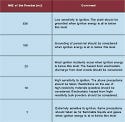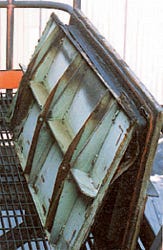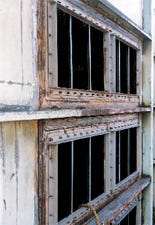Retrofitting Explosion Protection
May 14, 2007
|
Aluminum dust explosions at a plant manufacturing cast aluminum automotive wheels killed one worker, injured others, and damaged the facility. |
Explosion protection is still as much an art as a science today. The scientifically developed technical principles that are finally being embraced by leading corporate engineering departments have been slow to find their way into factories across North America and beyond. The obstacles and risk management decisions involved in protecting existing equipment and systems can be far more challenging than those experienced with new projects.
The need to retrofit can be driven by a number of factors: the use of products that have the capacity to explode—a potential that has long gone unrecognized; changes in processing that result in smaller particle size, higher concentrations or temperatures, or additional components that have increased volatility; an incident that heightens awareness; and intervention by regulatory authorities such as building inspectors, fire marshals, or insurance underwriters.
Most people are amazed at the array of everyday materials that can cause a catastrophic explosion under the wrong conditions. Such materials include coal, sugar, corn and sulfur dusts, propane, and methane. The broad spectrum of other materials that are susceptible to explosion includes aspirin, NutraSweet, cornstarch, pasta, tapioca, egg white dusts, tea and instant coffee, ground ginger, cocoa, tobacco, wood and paper dusts, laser toner, paint pigment, aluminum, sewage sludge, and most plastics. Consequently, hazards exist in food processing, pharmaceutical and cosmetics manufacturing, the automotive and aircraft industries, computers, refining, and many other sectors.
Preliminary Steps
Once the need to retrofit for explosion protection has been recognized, there are a number of preliminary steps that must be taken. Since it is irrational to isolate a given piece of equipment from the system in which it operates when assessing explosion protection needs, one should initiate a hazard and operability (HAZOP) review to assess areas of risk; rank their seriousness and likelihood; establish potential causes and how frequently they can occur; assess the potential for personnel injury or death, damage, lost production, etc.; and assign levels of risk acceptability to the various hazards identified.
|
An explosion and fire destroyed a pharmaceutical plant producing rubber stoppers and other products for medical use, causing six deaths, injuring 38 others, and causing hundreds of job losses. The fuel for the explosion was a fine plastic powder, which accumulated above a suspended ceiling over a manufacturing area. |
It then becomes necessary to identify solutions for each of the potential hazards that are beyond a level of acceptable risk. This process can become difficult when being filtered by subjective thinking that defies logic. From an explosion protection perspective, for example, a fire and “low-level” explosion should create a new recognition for the need to protect a dust collector. Depending on the type of incident, reactions can differ greatly. It is natural to be more aware of the potentially serious impact a major fire could cause after a small fire is contained without significant damage. Yet, too often, the previously unrecognized potential for a catastrophic future incident can be overlooked after a low-energy explosion that has not caused widespread destruction at a facility.
It is necessary to establish the basis on which the explosion protection design scenario should be founded and to determine which authorities the end-user is answerable to. With respect to design, the National Fire Protection Association (NFPA) has various design guidelines that may apply, including but not limited to NFPA68, Guide for Venting of Deflagrations; NFPA61, Prevention of Fires and Explosion in Agricultural & Food Processing Facilities; NFPA484, Combustible Metals, Metal Powders, and Metal Dusts; NFPA664, Prevention of Fires and Explosions in Wood Processing and Woodworking Facilities; and European Guideline VDI 3673, Pressure Venting of Dust Explosions.
While the authorities vary from one jurisdiction to another and one country to another, they generally include the insurance underwriter, fire marshal, building department, department of labor, and the plant’s health and safety committee. The recommended design path should offer a protection scenario that is going to be compatible with NFPA applicable guidelines and good engineering practices. Ultimately, it must be supported by the company’s insurance underwriter.
|
Table I: Implications of minimum ignition energy. These guidelines may not ensure safety in the case of powders in large nonconducting containers or when handling and storing granules or flakes. In those instances, the details should be referred to an expert. |
Designing a System
After accomplishing the preliminary steps, it is time to move on to design while anticipating some of the common hurdles. The first priority is to determine the design strength of the equipment, which is key to rationally protecting the system. One has to account for the containment pressures that need to be accommodated. Explosive pressure (Pmax) can attain levels in excess of 7.0 barg (~100 psig) in unvented equipment that was typically never designed to handle anything more than operating pressure and vacuum levels that would be created by the fan under design load—typically under 0.3 bar (5 psi).
Too often, system designers only consider the maximum vacuum design condition on a “pull-through” system, since positive pressure capability seems irrelevant—until assessing explosion protection requirements. Even if the original design strength is known, years of corrosion, abrasion, and fatigue make this a moving target. Also, the natural inclination to develop a conservatively low vacuum condition can be costly when implementing protection.
The underlying issue here is that as the vessel strength decreases, the vent area requirement increases when passive devices such as explosion vents or doors are used. Costs increase accordingly. Often, adding stiffeners to increase the perceived vessel strength can contribute to cost savings.
The explosibility of dust, gas, or a hybrid mixture, known as the Kst value (the rate of the pressure rise in bar meter/second), is crucial to rationalizing design. Often, risks vary from one part of the system to another because of the addition of other dusts or gases, attrition that takes place through the system, changes in dust loads, settling or stratification of the dusts, etc.
Dusts having the potential to explode are categorized into three classes under NFPA. ST1 has a Kst range of <200 bar m/sec, while ST2 covers 201–300 and ST3 has a range >300 bar m/sec. The lowest published Kst in NFPA68 is 9 bar m/sec (428 psi ft/sec) with an associated Pmax of 5.2 bar (75 psi), while the highest is a Kst of 415 bar m/sec (19,754 psi ft/sec) with a Pmax of 12.4 bar (180 psi).
To redesign a facility, it is necessary to know the Kst, the Pmax, and the particle size distribution. In principle, volatility increases as particle size decreases. Unfortunately, process-specific explosibility data are rarely available, and the generic numbers that may be published and used in calculations may not be accurate. For example, using generic values for coal may leave a system underprotected, since coal has a fairly wide explosive band depending on the type, moisture content, etc. There are more than 100 published Kst values for coal ranging from 37 to 176 bar m/sec (1761 to 8377 psi ft/sec), not
to speak of associated products such as carbon and coke. Similarly, there are more than 90 published Kst values for wood products ranging from 11 to 238 bar m/sec (524 to 11,329 psi-ft/sec). Thus, a generic value can be at great variance with the actual product being handled.
|
Table II: The MIE and MIT of common materials. A broad range of values exists for common materials, depending on particle size and distribution, moisture content, and other factors. These values should not be used as a design premise. |
For example, particle size and moisture content have a major influence on Kst and Pmax. Aluminum with a 0.5-mm (0.020-in.) particle size will not ignite, whereas fine aluminum flake can explode with a Kst in excess of 700 bar m/sec (33,320 psi ft/sec), causing a greater blast than a hydrogen/air explosion.
Just as generic data can be an issue, the testing method through which the data are derived can also be prolematic. Much of the data from the U.S. Bureau of Mines, for example, was found to be quite inaccurate using established Hartmann Test Bomb methods. While a range of test standards exists (e.g., ASTM E1226 in North America and ISO 6184/1 in Europe), a universal standard has not been adopted.
Material Safety Data Sheets (MSDS) rarely address Kst values or how explosive materials are; they merely state that the materials may explode. Moreover, not all MSDS can be relied on to address even the possibility of explosion, leading to eventual mishandling of materials if users assume that they cannot explode. Frequently, product manufacturers are not sufficiently aware of their materials’ explosibility, and they don’t test them because they don’t suspect them. Sometimes a product may not be explosive in the form in which it is supplied, but it can become explosive once a user processes it. This can happen in grinding and pulverizing operations or through attrition in pneumatic handling systems.
As far as explosibility is concerned, a more meaningful frame of reference may be Pmax, which is defined as the maximum pressure developed in a contained explosion of an optimum mixture. In other words, any piece of equipment containing dust is expected to withstand an internal pressure buildup of 7.9–8.3 barg (115–120 psig) in the event ignition takes place. When equipment is designed for pressure containment of less than that amount, structural failure can be expected, the magnitude of which depends on the severity of the incident and the actual yield strength of the equipment.
Knowing materials’ minimum ignition energy and temperatures (MIE and MIT) is often fundamental to arriving at HAZOP and risk management decisions. Materials with high ignition energy or temperatures are much more difficult to ignite than materials with low values, except in the event of open flames or welding incidents. The minimum ignition temperature for dispersed dust is principally used to ensure that surface temperatures cannot cause the dust to ignite. The MIT value measurement of the dust cloud is one criteria for selecting suitable electrical equipment in dusty atmospheres. The MIT value of the powder layer is also a relevant parameter.
|
Twin dust collectors during the retrofit of rupture membrane (diaphragm)-style explosion vents used to replace nonfunctioning heavy-latched doors on hinges |
Protection Technology
The technology used to protect against explosions can vary dramatically in price. Typical solutions from the least to the most expensive include:
Explosion doors or panels and rupture membrane–type vents.
Inerting.
Explosion suppression.
Explosion isolation.
Doors or panels and vents are passive devices that require little maintenance.
They perform double duty by serving as pressure-relieving devices and by preventing equipment overpressure failures. These passive failsafe devices are always preferable if they can be adapted to the system’s needs. They can be reasonably priced depending on the quantity and uniformity of the types used.
The most cost-effective approach, doors typically have low release-pressure capabilities. They are not as susceptible to fatigue failures as rupture membrane–type vents can be or as susceptible to changing release pressures with changes in temperature. Special or costly doors or panels can perform leak-tight service at service temperatures as high as 2000°F. Doors or panels can be more cost-effective in small quantities, but special attention should be paid to the closure design and hinging.
Rupture membrane–type vents can provide a leak-tight seal more readily than doors or panels in most cases. They have a relatively broad release-pressure tolerance and are more readily incorporated into systems with discharge ducts.
|
Doors with latches removed. The corroded hinges would prevent the doors from opening. |
The underwriting engineer, along with a technically credible equipment supplier, should be involved in the process early to ensure that the most acceptable and cost-effective protection approach is identified and implemented. The insurance underwriter should be seen as the owner’s partner in ensuring plant and personnel safety and as a resource to help minimize the potential of an underwriting loss.
Because of the growing awareness of explosion hazards, new designs place all or part of the system outdoors. Traditionally, equipment and systems requiring protection were often found indoors, impeding cost-effective protection. Installing discharge ducting to an outside wall or roof requires a large relief area because of induced backpressures in the venting process, increasing protection costs. Incorporating ducts that run longer than 10 ft can be impractical, while lengths greater than 20 ft often do not provide adequate system protection.
The plant, equipment, and personnel are potentially in danger if explosion-relief panels open indoors. It is important to ensure that fireballs and other hazardous discharges can escape from explosion-relief devices through a duct to an outside wall. Naturally, the longer the duct, the less effective the system is at expelling the huge volumes of expanding gases that are generated by an explosion. The influence zone of ducting discharges (fireballs, etc.) may also require the use of deflectors. However, the equipment in many cases is too far from the plant wall or roof to allow for discharge ducting.
|
Extra manpower was required to remove the doors that weighed more than 225 lb, far beyond the design constraints of NFPA68, even without hinges. |
Obstruction of roof access by process piping, wiring, overhead cranes, etc., may further complicate matters, especially because a discharge duct must be as straight as possible.
When NFPA68-compliant explosion vents or doors are utilized, their effectiveness can be negated by having a heavy or hinged flap or door on the outlet of the duct. Part of a hazardous operations review should be the potential of an explosion at start-up (often the most likely scenario). Whether a rupture membrane or door is used, the venting device may not be functional if ice and snow occasionally obstruct it. It is incorrect to assume that equipment operating temperatures will effectively melt ice or snow, since most incidents occur at start-up when the system is cold. In such cases, a discharge hood may be required to further induce backpressures. These considerations can result in the need for a facility to invest in more-expensive protection technologies.
|
New frame assemblies installed to accommodate NFPA-compliant rupture diaphragm-style explosion vents |
Effect of Condensation
Whether a facility must vent equipment that is indoors or outdoors, consideration should always be given to the effect of condensation that may occur on the process-side vent or door face. Should condensation occur, many materials will tend to bridge, cake, and possibly even harden or undergo crust formation. These phenomena can be detrimental to the venting system or even to the process itself. Such circumstances can call for the use of insulation of one type or another.
Awareness of what is being done at the outlet of the discharge duct is important. Working to NFPA68 standards and incorporating compliant devices on the equipment can be compromised by installing poorly engineered and possibly dysfunctional components at the outlet that are meant to serve as weather protection (such as a heavy hinged flap with latches). The use of such components may impede venting efficiency and not only affect the safety of the overall installation but also inappropriately transfer liability back to the OEM and suppliers if the explosion relief proves to be inadequate.
|
Support bars integrated into the base frame to allow for vacuum service |
Installation of Weathershields
An extra margin of safety can be applied by installing NFPA-compliant weathershields at the duct termination. The oversizing of discharge ducts is recommended to lower induced backpressures.
Accordingly, the weathershields should be larger than the primary vents and mount in a similar fashion to the vent. Often, ducts are outside the OEM or contractor’s purview. If so, their installation can be coordinated with a client to ensure that the retrofit is implemented in the most cost-effective and timely way.
Installing the best vents with frames is critical. If the precision of the bolt circle and spacing is not adequate, it may be impossible to make them interchangeable or to allow rotation of the upper assembly 180° to the base frame. Flatness and surface-finish problems can lead to inadequate sealing. Jigs used to fabricate frames ensure a high degree of precision and quality control.
The next priority is to ascertain the relief area requirements when using explosion vents or doors for the equipment in the system requiring protection. That equipment can include the ductwork itself and pneumatic conveying lines. NFPA68 or VDI 3673 provide equations and guidance in this area. When performing the necessary calculations—no matter the source—a high level of accuracy or precision should not be assumed, since the equations are based on laboratory-level testing. Scaling from small line sizes to test-level ducting systems may require that a safety factor be incorporated into the final design. The recommended safety factor relies on engineering judgments that will vary with the complexity of the system, the exactitude of the input values into the calculations, and the depth of the HAZOP that was undertaken. A 25% safety factor is a minimum value.
|
Completed retrofit of explosion vents. Despite many years of incident-free operation at this fertilizer plant, a faulty gas valve caused both collectors to experience significant explosions within eight weeks of the retrofit. While no damage or injuries occurred, all vents had to be replaced. |
The equipment for the protection scenario developed through the HAZOP must be identified, specified, and sourced. The purchaser should be aware that there can be a major difference between equipment supplied with “explosion protection” and that supplied with “explosion protection meeting the requirements of NFPA” or its equivalents. In addition, pertinent electrical classifications may result in equipment differences. The equipment may include spark detection, isolation, suppression, inerting systems, abort or diverter dampers, explosion-relief vents or panels, weathershields and weatherhoods, deflectors, pressure or heat detectors, magnetic pickups, etc.
The Installation Challenge
The installation of new explosion-protection equipment can be challenging. Generally, a facility is faced with a limited window of opportunity to perform the retrofit after the equipment has been shut down. Usually, the equipment is filled with dust and must be cleaned before the retrofit crew attempts to cut penetrations or weld mountings onto the vessel. Exchanging cloth bags for shorter cartridges on the dust collector may allow for more-efficient venting. Installing an interlock so that a pulsed-air system cannot be operated without the fan running is recommended. Mountings for the new equipment should be fabricated in advance of installation to allow for the best workmanship without the stresses of the start-up schedule.
Even for relatively simple devices such as rupture diaphragms, the application engineering involved in an explosion protection retrofit can be quite complex. An overly simplistic approach is to no one’s benefit, least of all those who happen to work near the system in the event of even a minor incident.
Paul Henderson is president of Henderson Industrial Specialties, Waterdown, ON, Canada.
The ExploGuard Div. provides technical support and equipment to OEMs, commodity producers, and those responsible for ensuring plant safety. For more information, contact the company at 905-690-0425 or www.exploguard.com. To request the free quarterly ExploGuard newsletter, contact [email protected].
About the Author(s)
You May Also Like














